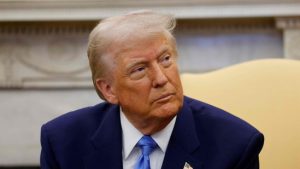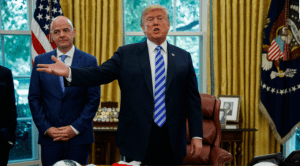New Delhi/Washington: India’s 100% tariff hike is not just a trade retaliation—it represents a strategic move to strengthen domestic industries while pushing for greater trade parity with the United States. Over the years, India has faced asymmetrical trade policies that have often disadvantaged its exports while allowing US goods to dominate key market segments.
This latest move is seen as part of India’s broader economic restructuring efforts, especially under initiatives like:
📌 “Make in India” – Encouraging local manufacturing
📌 “Atmanirbhar Bharat” – Promoting self-reliance and reducing import dependency
📌 “PLI Schemes” – Incentivizing domestic production and reducing reliance on foreign supply chains
By imposing higher tariffs on US agricultural products, luxury goods, and industrial machinery, India is creating a protective economic shield to help local businesses grow without external pricing pressures.
Why Did India Impose 100% Tariffs?
The tariff hike is driven by multiple economic and geopolitical factors, including:
✔️ Trade Imbalance – The US enjoys a trade surplus in certain sectors, with Indian exporters often facing higher duties on key goods like steel and textiles.
✔️ US Tariffs on Indian Goods – India has been subject to heavy US tariffs on steel, aluminum, and IT products, impacting its trade competitiveness.
✔️ Domestic Growth Focus – By making certain US imports less attractive due to higher costs, India is encouraging its businesses to step up production and innovation.
✔️ Geopolitical and Strategic Considerations – Amid shifting global alliances and supply chain realignments, India is using its growing economic influence to demand fairer trade terms.
This move sends a clear message that India will not accept one-sided trade practices and is willing to take decisive steps to ensure fairness in international commerce.
The US administration has taken note of India’s tariff hike, with White House officials signaling potential countermeasures. In a strong statement, US trade representatives emphasized that Washington would explore reciprocal trade actions if India’s policies continued to affect American businesses.
📌 Possible US Countermeasures:
-
Imposing higher tariffs on Indian textile and IT exports
-
Restricting market access for Indian pharma and auto exports
-
Reviewing trade agreements affecting India’s access to US markets
With trade negotiations intensifying, the global economic community is watching closely to see how US-India trade relations evolve in the coming weeks.
White House Response: “Time for Reciprocity”
The US administration’s reaction to India’s tariff hike has been swift and direct. The White House has emphasized that if India continues to impose restrictive tariffs, the US will explore countermeasures to protect its own economic interests.
Possible US Counteractions
📌 Higher tariffs on Indian textiles, pharmaceuticals, and IT exports
📌 Tighter restrictions on outsourcing and H-1B visa allocations
📌 Reevaluating trade agreements, including GSP (Generalized System of Preferences)
With trade tensions rising, both nations are at a critical juncture. While the US pushes for retaliatory measures, India remains firm in its commitment to rebalancing trade terms.
Impact on Indian and US Markets
India’s tariff decision will have far-reaching consequences for businesses and consumers on both sides:
Impact on US Businesses
❌ Loss of Market Share – US exporters will lose price competitiveness, making Indian and alternate suppliers more attractive.
❌ Supply Chain Disruptions – Businesses that depend on Indian raw materials could face cost pressures.
❌ Reduced Agricultural Exports – US farmers who heavily rely on Indian markets for almonds, apples, and other crops will see reduced demand.
Impact on Indian Consumers & Businesses

✔️ More Demand for Local Products – Indian businesses producing alternatives to US goods will benefit from a boost in sales and expansion opportunities.
✔️ Higher Prices for Imported US Goods – Consumers who rely on US-brand products will face higher costs or will have to shift to domestic alternatives.
✔️ Stronger Local Manufacturing – Indian manufacturers in automobiles, tech, and consumer goods will gain market share, supporting economic growth and job creation.
Future of US-India Trade Relations: Negotiation or Trade War?
While the 100% tariff decision has escalated tensions, trade experts believe that both nations may still opt for diplomatic discussions to prevent long-term disruptions.
✔️ India and the US are key economic partners, with bilateral trade exceeding $190 billion annually.
✔️ Both countries benefit from tech, defense, and strategic partnerships, making full-scale trade retaliation unlikely.
✔️ Upcoming diplomatic engagements may provide a platform for revisiting trade policies and negotiating new agreements.
While some level of retaliation from the US is expected, the larger focus will be on renegotiating trade terms in a way that ensures mutual economic benefits.
What Led to India’s Tariff Decision?
India’s move to increase tariffs on US goods follows:
📌 Longstanding trade imbalances in key sectors
📌 US-imposed tariffs on Indian steel and aluminum exports
📌 Recent American subsidies favoring US-based manufacturers
📌 A push to support local farmers and domestic manufacturers
Economic experts believe India’s strategy is aimed at leveraging its growing global economic influence while ensuring fairer trade terms with the US.
Conclusion: A Defining Moment for US-India Trade Relations


As the world watches this unfolding economic standoff, one thing is clear—India is taking a firm stand on trade fairness, setting the stage for a new chapter in global trade negotiations. For further details on India’s tariff policies, visit the official Ministry of Commerce and Industry website.
For more real time updates, visit Channel 6 Network.

